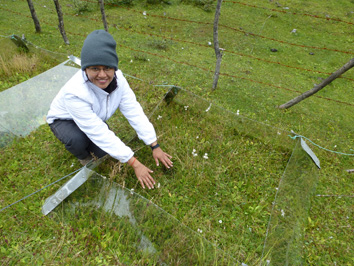Chemical ecology

Joyshree Chanam
joyshreec at ncbs dot res dot in
 joyshreec [at] ncbs [dot] res [dot] in
joyshreec [at] ncbs [dot] res [dot] in
Joyshree Chanam (Visiting Fellow)
My research interest lies mainly in the domain of chemical ecology, the silent language of nature, with which I attempt to eavesdrop into what plants and insects say to each other, and understand the relationships they share.
My Post-doc project is to investigate the effect of climate change on volatiles and chemical defense compounds of plants, and its consequences on plant-insect interactions (pollination and herbivory). This study is being conducted along an altitudinal gradient in the alpine ecosystems of the Eastern Himalayas Biodiversity Hotspot.
During my PhD, I investigated the interaction between the ant-plant Humboldtia brunonis (Fabaceae) and the ants and other invertebrates associated with it. This plant is an understorey tree, endemic to the wet tropical evergreen forests of the Western Ghats. Unlike most ant-plants that have a protection-based mutualism with specific ant partners, H. brunonis is associated mostly with non-protective ants, and other non-ant invertebrates, and only one associated ant species gives significant protection. However, this plant continues to produce rewards such as nesting space (caulinary domatia) and food (extrafloral nectar) for ants even at those sites where protection was not significant.
Using stable isotope techniques, we discovered that the protective as well as non-protective ants and other invertebrates residing in the plant indeed contribute significant amount of nitrogen to the host plant through their debris and organic waste. This study suggests that myrmecophytism could have evolved through nutrient mutualism, in addition to or even in the absence of protection mutualism. We also discovered geographic variation as well as context dependency in the rewards produced, implying higher investments on rewards to attract protective ants when herbivory pressure is high.

Publications
- Chanam, J., Srinivasan, K., Pramanik, G. K., Jagdeesh, A., Joshi, K., and Borges, R. M. 2014. Foliar extrafloral nectar of Humboldtia brunonis (Fabaceae), a paleotropical ant-plant, is richer than phloem sap and more attractive than honeydew. Biotropica doi: 10.1111/btp.12185 [link]
- Chanam, J., Sheshshayee, M. S., Srinivasan, K., Jagdeesh, A., Joshi, K., and Borges, R. M. 2014. Nutritional benefits from domatia inhabitants in an ant–plant interaction: interlopers do pay the rent. Functional Ecology doi: 10.1111/1365-2435.12251 [link]
- Chanam, J., Srinivasan, K., Pramanik, G. K., Jagdeesh, A., Joshi, K., and Borges, R. M. 2014. Context dependency of rewards and services in an Indian ant–plant interaction: southern sites favour the mutualism between plants and ants. Journal of Tropical Ecology 30: 219–229 [link]
Popular Science Writing
- Humboldtia: the perfect host. January 15, 2015. JLR-Explore, online natural history magazine [link]
- Ants in my Plants. June 25, 2014. The Hindu, national daily newspaper [link]
- For the love of Honeydew. June 20, 2014. The Hindu, national daily newspaper [link]
- Mired by progress. 2010. Current Conservation, 4.2:37-38 [link]
- Forced to adulthood by global warming. 2010. Current Conservation, 4.2: 36-37 [link]



